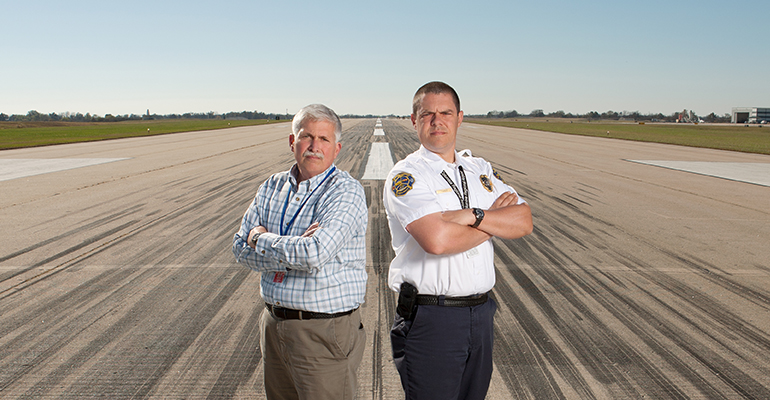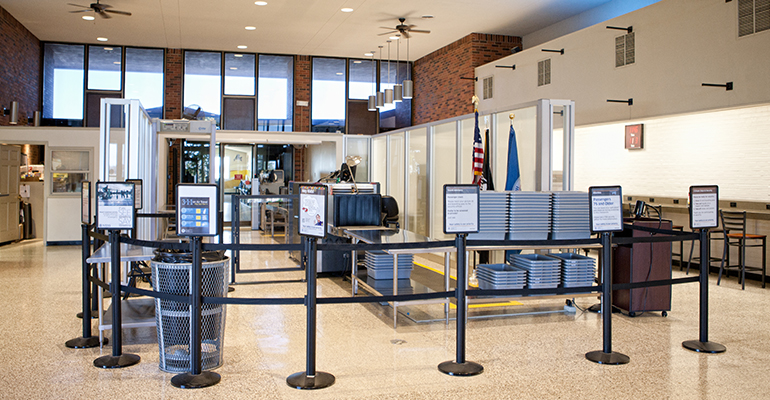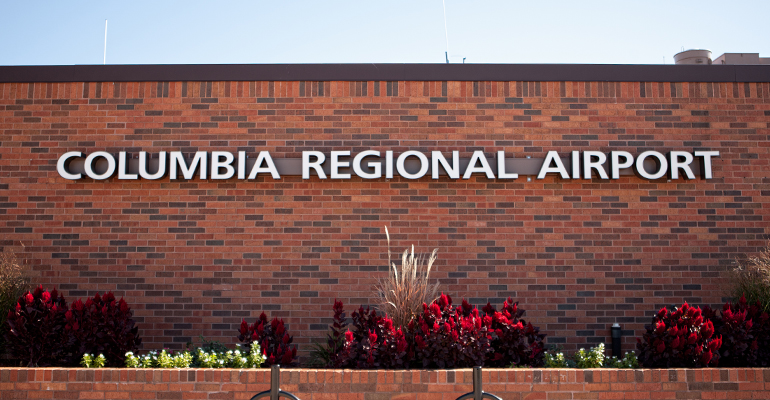Columbia Regional Airport serves record passengers in October
- photos by Anthony Jinson

It’s the simple improvements that can make the difference for a passenger at Columbia Regional Airport. Just ask anyone who’s ever gone through security and then needed to relieve themselves.
Airport Manager Don Elliott says the new ADA-compliant restroom in the passenger holding area will not only help relieve passengers, but will also speed up the check-in process.
“In the past, passengers, once they got in the holding area, if they had to use the restroom before they board the flight, they’d have to go through and go out the screening point, then go through the screening process again,” Elliott says. “Now, it’s much more convenient, and it makes the TSA line more efficient.”
Customer-centric improvements have been the focus this year for airport staff, and that focus reflects a growth period with major improvements ahead.
The Skyline Café, located on the second floor and accessible only by a flight of stairs, closed earlier this year, leaving a vacancy for food and beverages available at the airport. In October, the airport opened a snack bar on the first floor, with convenient food and beverages. The snack bar takes up previously unused space in the terminal, and Elliott says they’re working to incorporate mid-Missouri products there. Harold’s Doughnuts is the first local vendor, and Elliott says that the doughnuts have sold “like hotcakes.”
For now, the Parks and Recreation concessions team is managing the snack bar, though Elliott hopes an outside company will take over operations soon.
There’s also an Internet bar, workstations, USB ports and more seating — which is good, since October saw 12,017 passengers, the highest monthly commercial passenger traffic in the history of the airport, according to COU statistics.
Though passenger counts have not been released for November and are not yet known for December, 2015 passenger numbers should mark a high since 1978. Elliott credits the convenience of the airport and an increase in reliability of flights for the continued growth.
In 2008, Elliott says, COU was ranked “around 398” when compared to commercial airports across the country. Today, COU ranks around 260.
“In 2008, we were on life support,” says Elliot, who has worked at the airport for more than 33 years. “We were an EAS: essential air service airport. Now, I think we’ve made an amazing recovery, and we’re a growing, healthy airport.”
Elliott credits mid-Missouri communities – Boone County, Cole County, Jefferson City and Columbia – working together to realize the importance of the airport to economic development.
“We live in a different time,” Elliott says. “We want connectivity throughout the world. And flying into major international hubs is the key. And it took everyone from the mayor, city manager, public works director and council to make a difference, and the business community. It took everyone working together.”
In order to experience the kind of growth that’s possible, COU is looking to the future, and to host a larger variety of aircrafts, improvements must be made to the runway. The crosswind runway intersection has been under construction since July, and it should be completed in late November.
The goal is to expand the crosswind runway first, followed by the main runway. When work on the crosswind runway is complete, it will increase by 1,100 feet in length, 25 feet in width and will be resurfaced from asphalt to concrete. When completed, it will allow 70-passenger jets to land.
Work on the rest of the crosswind runway will begin in 2016, with construction following in 2017. After that, work to extend the main runway north will begin, and designs for that project would probably happen in 2018. Whether that means rehabbing or reconstructing, engineering reports will say. But before that, Route H will need to be rerouted to extend the runway safety area.
Elliott says lengthening the main runway will allow larger varieties of aircrafts to use the airport. The project would add another 900 feet to the main runway, making the total length 7,400 feet.
Currently the airport serves 64-passenger jets to Chicago and 50-passenger jets to Dallas. Flights depart to each destination in the morning and afternoon, with an arrival from each in the afternoon and at night. Acquiring a third destination is a top goal for Elliott, who serves as a sort of lobbyist, on behalf of COU, to the airlines.
“I make contact in-person with the airlines quite often, so far it’s been about three times this year,” Elliott says. “And just to keep Columbia on their radar, let them know the success that we’re having and let them know about not just Columbia, but mid-Missouri, and just keep getting the word out.”
Elliott says he thinks the airport could sustain flights to and from a leisure market. There are several low-cost carriers traveling to vacation destinations, like Florida or Las Vegas. The increase in passengers and the potential increase in number of flights has led to discussion of long-term solutions for the airport. That means the discussion and exploration of a larger terminal. The current terminal was completed in 1968.
The current terminal has grown since the ’70s, Elliott says, when the passenger holding area was outdoors, before being moved into a doublewide trailer. Later, a second doublewide was added for baggage claim, then baggage claim was moved to a third doublewide to make room for a second gate.
“I don’t want to see another doublewide,” Elliott says.
Through a MoDOT grant, the city is in the process of putting together a terminal area master plan, with an engineering firm and cooperation from the FAA, to determine whether to rehab the current terminal or build on greenspace.
“Once we started getting larger aircraft and had more passengers flowing through the terminal, we had to once again look at what’s going to serve the airport for the short term and long term,” Elliott says. “Do we want to do a short-term fix and invest the money into that? Or do we want to do a long-term fix that will serve mid-Missouri the next 75 to 100 years? So we’re conducting a study of all the factors that can affect the terminal building.”
Tentative plans would be for four gates in the new terminal, with the ability to expand in the future. The current terminal’s location, sandwiched by Central Missouri Aviation, would make that difficult.
The new terminal would allow the airport to meet ADA requirements, to make the passenger experience more comfortable and to include modern amenities, Elliott says. But, he doesn’t want to lose the comfortable feeling of a smaller airport.
Barriers to the project include meeting stringent FAA requirements and financing the project.
Today, the city employs 16 at the airport, but including the staff of Central Missouri Aviation, Ozark Management Hanger, American Airlines, the post office, car rental and other employees, more than 250 people work at the airport. In 2012, MoDOT conducted an economic impact report examining the impact of the airport on mid-Missouri. They looked at direct impacts, meaning the employment, wages and sales generated by airport business; indirect impacts, like the money visitors spent on food, hotels, transportation and entertainment; and induced impacts, meaning the spin-off effects of employees or passengers purchasing goods and services.
According to the report, the airport has created 745 total jobs, directly and indirectly, with a total payroll of $26,925,000 and a total output, or the total expenditures of goods, services and capital, of $87,179,000.
COU will continue to outperform other airports, Elliott says, when it comes to customer service. “Whether it’s making sure people aren’t snowed in at the airport, or if they’ve got a flat tire, ‘Hey, we have an air tank.’ We’re going to help them. You don’t get that at other airports.”




